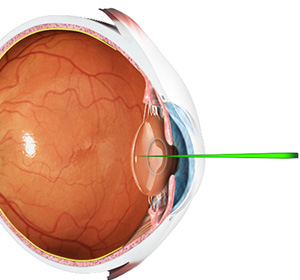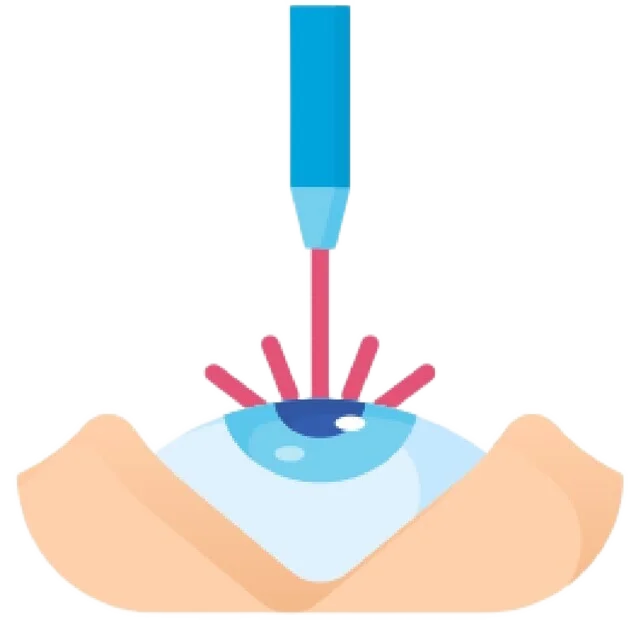
What is YAG Capsulotomy?
YAG capsulotomy is a procedure that is used in the treatment of posterior capsular thickening which is a common but long-term complication of cataract surgery.
During cataract surgery, the lens of the eye is removed and replaced with a plastic lens, which rests on a capsule (transparent membrane). In some patients, the capsule can thicken and become opaque, interrupting the entry of light. When this happens, you may experience a gradual reduction in vision. Posterior capsular thickening can happen any time after your cataract operation from a few months to years. YAG capsulotomy is performed to restore your vision to how it was after the cataract operation.
Procedure of YAG Capsulotomy
YAG capsulotomy is performed under local anaesthesia. Your ophthalmologist first checks your vision and instils drops to dilate your pupils. Pressure lowering drops may also be administered. To keep the eye open and focus the laser beam, a special contact lens is placed on the eye. Your doctor then uses a laser beam to create a small opening in the clouded capsule, in order to provide a clear path through which light can pass. You will hear beeping noises and experience bright lights during the process. The whole procedure lasts for approximately 5 to 10 minutes.
After YAG capsulotomy, you will be monitored for any increase in eye pressure. Your doctor may prescribe eye drops or tablets to protect the eye against short-term increases in pressure. Contact your doctor if you experience a sudden shower of floaters, flashes of light in the eyes, severe pain or loss of vision after the laser treatment.
How Long Does Yag Capsulotomy Last?
Yag capsulotomy, a common procedure performed to treat posterior capsule opacification (PCO) after cataract surgery, offers long-lasting results for patients. PCO occurs when the posterior capsule, which holds the artificial lens implanted during cataract surgery, becomes cloudy or thickened, leading to visual disturbances. Yag capsulotomy involves using a Yag laser to create a small opening in the cloudy capsule, allowing light to pass through and restoring clear vision.
The duration of the effects of Yag capsulotomy can vary from patient to patient. In many cases, the procedure provides permanent improvement in vision, allowing patients to enjoy clear eyesight for years after the treatment. However, some individuals may experience a recurrence of PCO over time, requiring additional intervention. Factors such as the patient’s overall eye health, the severity of PCO, and any underlying conditions can influence the long-term effectiveness of Yag capsulotomy.
Despite the potential for PCO recurrence, Yag capsulotomy remains a highly effective and durable solution for addressing visual disturbances caused by posterior capsule opacification. Regular follow-up appointments with an eye care professional can help monitor the condition and identify any changes in vision that may necessitate further treatment.
What Is the Cost of Yag Laser Capsulotomy in the UK?
The Yag capsulotomy cost in the UK can vary depending on several factors, including the specific clinic or hospital where the procedure is performed, the surgeon’s fees, and any additional services or tests required before or after the treatment. On average, patients can expect to pay anywhere from £500 to £1000 per eye for Yag laser capsulotomy.
It’s essential to note that the Yag laser capsulotomy cost may not be fully covered by the health insurance, especially if the procedure is deemed elective or non-urgent. Patients should check with their healthcare provider or insurance company to determine coverage options and any out-of-pocket expenses they may incur.
Despite the potential cost, many patients find Yag capsulotomy to be a worthwhile investment in their visual health and quality of life. Clear vision is invaluable, and for those experiencing visual disturbances due to posterior capsule opacification, Yag laser capsulotomy can provide a cost-effective solution for restoring clear eyesight.
Is Yag Capsulotomy Safe?
Yag capsulotomy is considered a safe and well-established procedure for treating posterior capsule opacification after cataract surgery. The Yag laser used in the treatment emits highly focused energy pulses that precisely target the cloudy posterior capsule, creating a small opening without damaging surrounding ocular structures.
Serious complications from Yag capsulotomy are rare but can occur in some cases. These complications may include increased intraocular pressure, retinal detachment, or inflammation in the eye. However, with careful preoperative evaluation, precise surgical technique, and appropriate postoperative care, the risk of complications is minimised.
Most patients undergoing Yag capsulotomy experience little to no discomfort during the procedure and typically resume normal activities shortly afterward. Any mild discomfort or irritation following the treatment can usually be managed with over-the-counter pain relievers or prescribed eye drops.
As with any medical procedure, it’s essential for patients to discuss the potential risks and benefits of Yag capsulotomy with their eye care provider and make an informed decision based on their individual circumstances.
What Is the Success Rate of Yag Laser Capsulotomy?
The success rate of Yag laser capsulotomy is exceptionally high, with the majority of patients experiencing significant improvement in vision following the procedure. Studies have shown that Yag capsulotomy effectively restores clear vision in over 90% of cases, making it a reliable and predictable treatment option for posterior capsule opacification.
The success of Yag capsulotomy is attributed to its ability to precisely target and create an opening in the cloudy posterior capsule, allowing light to pass through and reach the retina unimpeded. Patients typically notice a rapid improvement in vision shortly after the procedure, with many reporting clearer and sharper eyesight almost immediately.
While Yag capsulotomy is highly effective, it’s essential to recognise that individual outcomes may vary depending on factors such as the severity of posterior capsule opacification, the patient’s overall eye health, and any underlying conditions. Additionally, some patients may require more than one Yag capsulotomy procedure to achieve optimal results.
Overall, Yag laser capsulotomy boasts an impressive success rate and remains a cornerstone in the management of posterior capsule opacification, providing patients with a safe, effective, and minimally invasive solution for visual disturbances following cataract surgery.
What Is the Alternative to Yag Laser Capsulotomy?
While Yag laser capsulotomy is the most commonly performed procedure for treating posterior capsule opacification, several alternatives exist for patients who may not be suitable candidates for or prefer to explore alternative options.
One such alternative is neodymium-doped yttrium aluminum garnet (Nd:YAG) laser capsulotomy, which utilises a different type of laser to create an opening in the cloudy posterior capsule. Although similar in principle to Yag capsulotomy, Nd:YAG laser capsulotomy may offer certain advantages for specific patients, such as those with particularly thick or dense posterior capsules.
Another alternative to Yag laser capsulotomy is surgical capsulotomy, where an ophthalmic surgeon manually opens the cloudy posterior capsule using microsurgical instruments. While less common than laser capsulotomy, surgical capsulotomy may be preferred in cases where laser treatment is not feasible or deemed less effective.
In addition to these procedural alternatives, some patients may benefit from pharmacological interventions or lifestyle modifications to manage posterior capsule opacification and associated visual disturbances. These approaches may include the use of anti-inflammatory medications, nutritional supplements, or changes in eyeglass prescription.
Ultimately, the choice of treatment for posterior capsule opacification depends on various factors, including the patient’s individual preferences, overall eye health, and the severity of the condition. Patients should consult with their eye care provider to explore the available options and determine the most suitable course of action tailored to their needs.
Overall, Yag laser capsulotomy remains the gold standard for treating posterior capsule opacification, offering a safe, effective, and minimally invasive solution for restoring clear vision and improving quality of life for patients. However, for those who may not be candidates for Yag capsulotomy or prefer alternative approaches, several viable options exist to address this common postoperative complication following cataract surgery.







